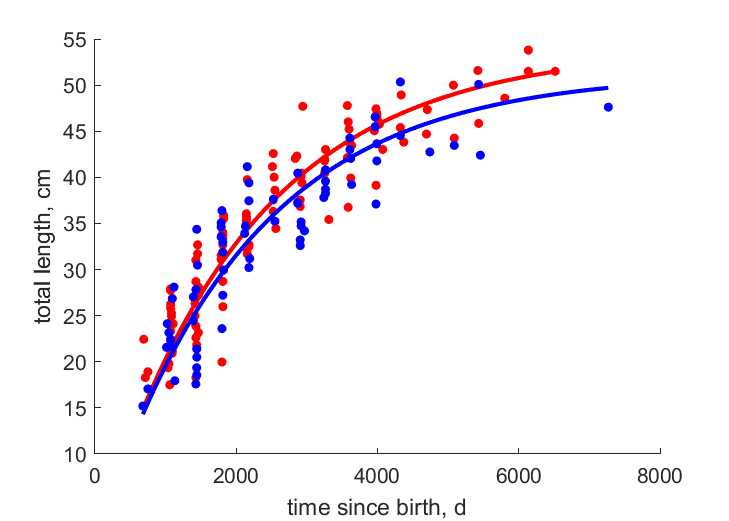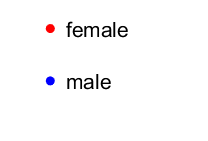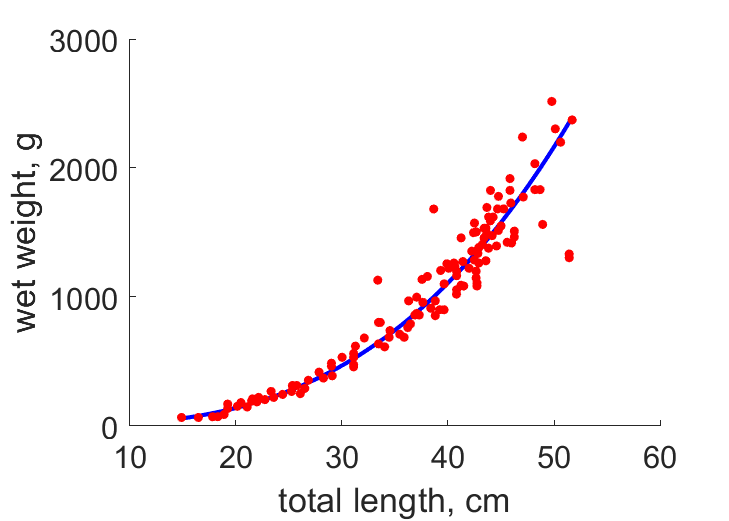Predictions & Data for this entry
| Model: abj | climate: MB | migrate: | phylum: |
| COMPLETE = 2.5 | ecozone: MPNE | food: bjPz, jiCi, jiCvf | class: |
| MRE = 0.043 | habitat: 0jMp, jiMdb | gender: D | order: |
| SMSE = 0.007 | embryo: Mv | reprod: O | family: |
Zero-variate data
| Data | Observed | Predicted | (RE) | Unit | Description | Reference |
|---|---|---|---|---|---|---|
| am | 1.241e+04 | 1.246e+04 | (0.0042) | d | life span | fishbase |
| Lp | 31 | 30.72 | (0.008931) | cm | total length at puberty | fishbase |
| Li | 56 | 57.19 | (0.02116) | cm | ultimate total length | fishbase |
| Wwb | 0.000268 | 0.0002672 | (0.003127) | g | ultimate wet weight | guess |
| Ri | 1858 | 1855 | (0.00137) | #/d | maximum reprod rate | fishbase |
Uni- and bivariate data
| Data | Figure | Independent variable | Dependent variable | (RE) | Reference |
|---|---|---|---|---|---|
| tL_f |   | time since birth | total length | (0.07437) | LoveJohn1998 |
| tL_m |   | time since birth | total length | (0.09805) | LoveJohn1998 |
| LWw |  | total length | wet weight | (0.1161) | LoveJohn1998 |
Pseudo-data at Tref = 20°C
| Data | Generalised animal | Sebastes auriculatus | Unit | Description |
|---|---|---|---|---|
| v | 0.02 | 0.02278 | cm/d | energy conductance |
| kap | 0.8 | 0.8721 | - | allocation fraction to soma |
| kap_R | 0.95 | 0.95 | - | reproduction efficiency |
| p_M | 18 | 29.72 | J/d.cm^3 | vol-spec som maint |
| k_J | 0.002 | 0.002 | 1/d | maturity maint rate coefficient |
| kap_G | 0.8 | 0.8022 | - | growth efficiency |
| k | 0.3 | 0.3509 | - | maintenance ratio |
Discussion
- In view of low somatic maintenance, pseudodata k_J = 0.002 1/d is replaced by pseudodata k = 0.3
- Males are assumed to differ from females by {p_Am} only
- mod_1: males have equal state variables at b, compared to females
Facts
- preferred temperature 15 C; (Ref: AndrHech1996)
- Demersal; depth range 20 - 275 m. Larvae and juveniles are pelagic (Ref: fishbase)
- ovoviviparous (although fishbase actually reports viviparous) (Ref: fishbase)
- length-weight: W in g = 0.01000*(TL in cm)^3.08 (Ref: fishbase)
Bibliography